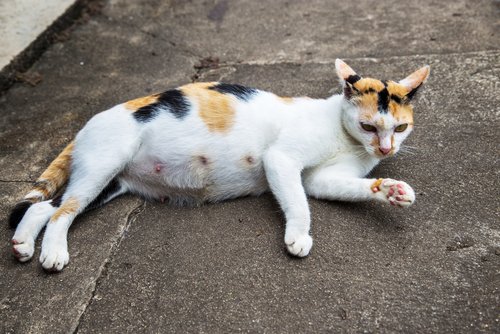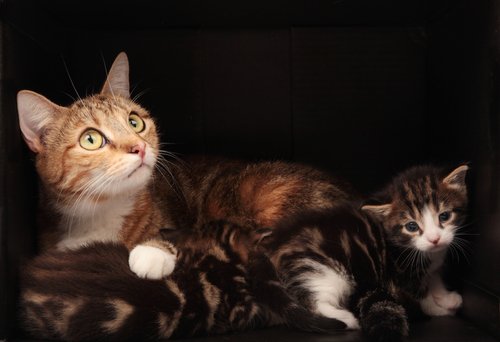When Cats Are in Labor: 6 Threatening Symptoms


Written and verified by the lawyer Francisco María García
Several complications can take place when cats are in labor. For example, a fever, hemorrhages, or the difficulty and inability of the kittens to exit the uterine canal.
However, cats, in general, are able to give birth to their babies without complications that put their lives or the lives of their offspring at risk. On the other hand, it’s important to recognize symptoms that can indicate that something is wrong. The most common problem can be the kitten’s size. Sometimes, as with Persian cats, childbirth can be more difficult because their offsprings’ heads are larger.
Dystocia when cats are in labor

Dystocia is the difficulty or inability of the kittens to pass through the mother’s birth canal. In general, this is the most common cause of complications when cats are in labor. The size of the offspring is usually the most common reason for this type of problem.
Complications and when to go to the vet
Sometimes when cats are in labor, it’s advisable to go to the veterinarian:
Interruption during the birth of the kittens
Each cat will have kittens at different intervals and at their own pace. Therefore, some cats will give birth to the first kitten and then take two hours to have the next one. On the other hand, there are others that will give birth to all the kittens one after the other.
However, keep in mind that if there is an interruption during the delivery of more than four hours between the birth of one kitten and another, this is a clear sign of a problem.
Although it’s rare for a mother to experience complication while the kittens are passing through the uterine canal, it still happens. In such cases, it is likely that the cat will need a cesarean section or help from a veterinarian to extract the kittens.
Dark colored liquid
When there is a dark-colored liquid after delivery, this is a sign of a problem. A brown liquid with a bad smell is an indication that there may be a uterine infection or that dead kitten has been left inside the uterine cavity.
When this happens, taking the cat to the vet is necessary. This is especially true when the amount of liquid doesn’t lower as days pass and the unpleasant smell still remains.
Fever when cats are in labor
When the mother has a fever during the delivery of her kittens, she may be suffering from some type of infection. Therefore, when this happens, you should contact a veterinarian. In addition, if it’s a long delivery, the birth canal is exposed, like an open wound, she may be a risk of getting an infection that can cause fever. Also, if there is a spontaneous miscarriage of kittens, this can cause an infection in the uterus.
The mother’s attitude
The behavior of the cat during labor is a sign that indicates if everything is on the right track. If the animal is inactive or sleepy, this can be a sign that she is sick. Also, it could indicate some kind of disease due to problems such as internal bleeding. On the other hand, it could show that the animal is exhausted and may need help bringing the kittens into the world.

Bleeding during childbirth
During delivery, cats will expel placental fluid, as all mammalian females do. However, if this liquid becomes bloody with a dark, thick color, then you should take your cat to the vet. This could be a symptom of a complication such as a uterine rupture.
Ultrasound
It can be a good idea to get an ultrasound done for your pregnant cat. This will allow you to know the number of kittens your cat is going to have. It also you to detect any kittens that have died in the uterus.
A healthy animal
A cat that is healthy and has a proper weight is likely to have a litter in good condition and give birth to them without having any problems. Excess fat will cause difficulties. It may be more difficult for the offspring to pass through the uterine canal. Therefore, it’s best that the mother isn’t overweight when she becomes pregnant, during pregnancy, or while in labor.
Several complications can take place when cats are in labor. For example, a fever, hemorrhages, or the difficulty and inability of the kittens to exit the uterine canal.
However, cats, in general, are able to give birth to their babies without complications that put their lives or the lives of their offspring at risk. On the other hand, it’s important to recognize symptoms that can indicate that something is wrong. The most common problem can be the kitten’s size. Sometimes, as with Persian cats, childbirth can be more difficult because their offsprings’ heads are larger.
Dystocia when cats are in labor

Dystocia is the difficulty or inability of the kittens to pass through the mother’s birth canal. In general, this is the most common cause of complications when cats are in labor. The size of the offspring is usually the most common reason for this type of problem.
Complications and when to go to the vet
Sometimes when cats are in labor, it’s advisable to go to the veterinarian:
Interruption during the birth of the kittens
Each cat will have kittens at different intervals and at their own pace. Therefore, some cats will give birth to the first kitten and then take two hours to have the next one. On the other hand, there are others that will give birth to all the kittens one after the other.
However, keep in mind that if there is an interruption during the delivery of more than four hours between the birth of one kitten and another, this is a clear sign of a problem.
Although it’s rare for a mother to experience complication while the kittens are passing through the uterine canal, it still happens. In such cases, it is likely that the cat will need a cesarean section or help from a veterinarian to extract the kittens.
Dark colored liquid
When there is a dark-colored liquid after delivery, this is a sign of a problem. A brown liquid with a bad smell is an indication that there may be a uterine infection or that dead kitten has been left inside the uterine cavity.
When this happens, taking the cat to the vet is necessary. This is especially true when the amount of liquid doesn’t lower as days pass and the unpleasant smell still remains.
Fever when cats are in labor
When the mother has a fever during the delivery of her kittens, she may be suffering from some type of infection. Therefore, when this happens, you should contact a veterinarian. In addition, if it’s a long delivery, the birth canal is exposed, like an open wound, she may be a risk of getting an infection that can cause fever. Also, if there is a spontaneous miscarriage of kittens, this can cause an infection in the uterus.
The mother’s attitude
The behavior of the cat during labor is a sign that indicates if everything is on the right track. If the animal is inactive or sleepy, this can be a sign that she is sick. Also, it could indicate some kind of disease due to problems such as internal bleeding. On the other hand, it could show that the animal is exhausted and may need help bringing the kittens into the world.

Bleeding during childbirth
During delivery, cats will expel placental fluid, as all mammalian females do. However, if this liquid becomes bloody with a dark, thick color, then you should take your cat to the vet. This could be a symptom of a complication such as a uterine rupture.
Ultrasound
It can be a good idea to get an ultrasound done for your pregnant cat. This will allow you to know the number of kittens your cat is going to have. It also you to detect any kittens that have died in the uterus.
A healthy animal
A cat that is healthy and has a proper weight is likely to have a litter in good condition and give birth to them without having any problems. Excess fat will cause difficulties. It may be more difficult for the offspring to pass through the uterine canal. Therefore, it’s best that the mother isn’t overweight when she becomes pregnant, during pregnancy, or while in labor.
This text is provided for informational purposes only and does not replace consultation with a professional. If in doubt, consult your specialist.








